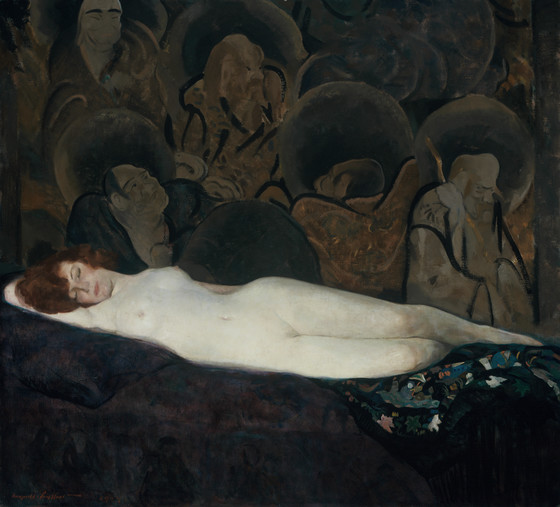From 1916 to 1922 Seyffert produced a number of major canvases devoted to the nude, and these were so well received when they were exhibited throughout the country that they were usually immediately a...
From 1916 to 1922 Seyffert produced a number of major canvases devoted to the nude, and these were so well received when they were exhibited throughout the country that they were usually immediately acquired for major museums. The most modernist works Seyffert was ever to produce, these canvases were no doubt influenced by the nude studies painted by his friend Arthur B. Caries. Both men used the same model, beautiful red-haired Grace Vernon, better known as "Bobby," who would later become Seyffert’s second wife. In several paintings Seyffert placed Bobby in highly decorative interiors with an ornate oriental screen, panel, or drape as a backdrop. Her body was treated as a single form and her extremities generalized or attenuated. In The Lacquer Screen, 1918 (Pennsylvania Academy of the Fine Arts, Philadelphia), the curves of the nude echo the calligraphic lines in the Chinese coromandel screen behind her, but in Nude with Chinese Background the figure is more abstracted, her linear body contrasting with the curving lines depicting the lohans (enlightened disciples of the Buddha) on the background panel. By stylizing the figure and using a creamy ivory, Seyffert accentuated the woman’s sensuous flesh. She appears almost luminous, the shadows on her skin colored by softer tints of the deep burgundy and green in the drapery and the earth-colored panel that surround her.
The painting was altered by the artist after it was first exhibited. When shown at the Pennsylvania Academy annual in 1919, it was entitled Silver Screen, after the burnished silver screen behind the figure. Seyffert decided to repaint the background in about 1920, incorporating a much more elaborate panel, somewhat like the one in The Lacquer Screen. He painted the background in large, sweeping strokes, and the lohans seem to take on a life of their own. William Preston Harrison, who bought the painting from the artist, had seen the work in both its original and altered states.
More...
